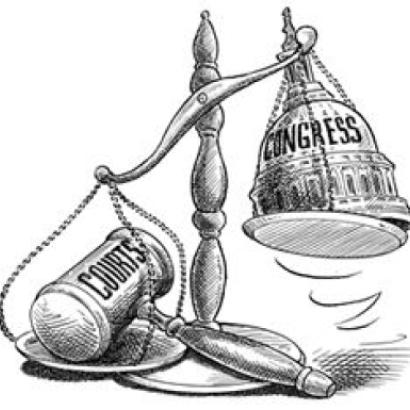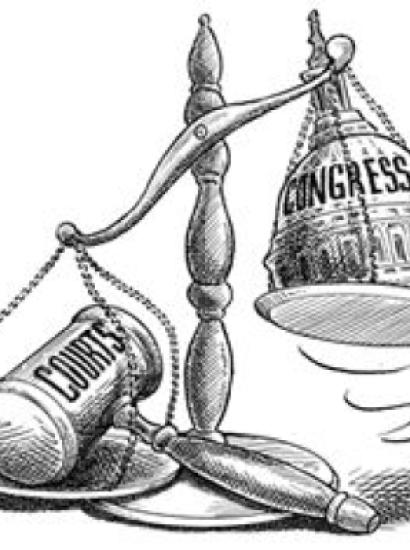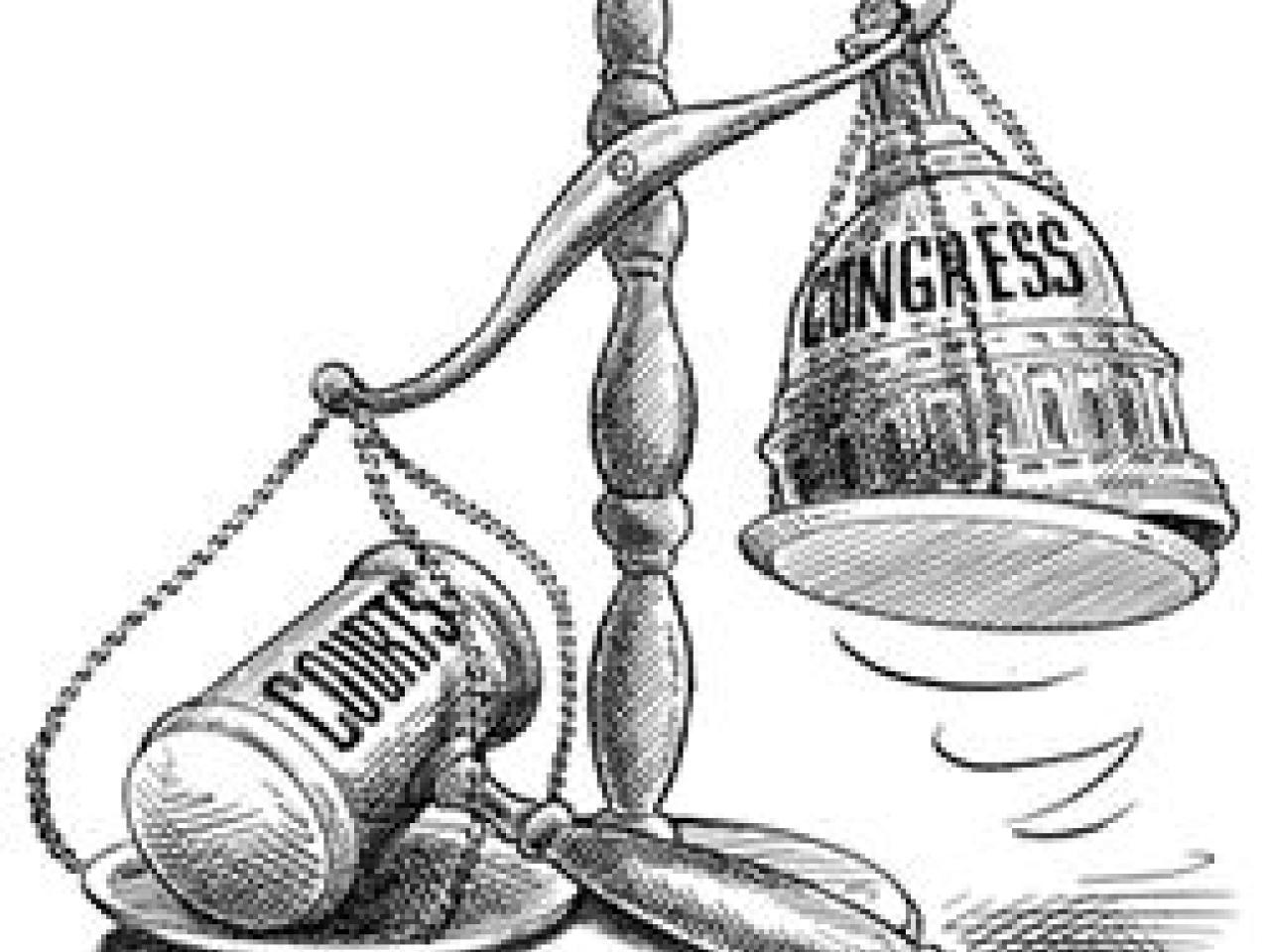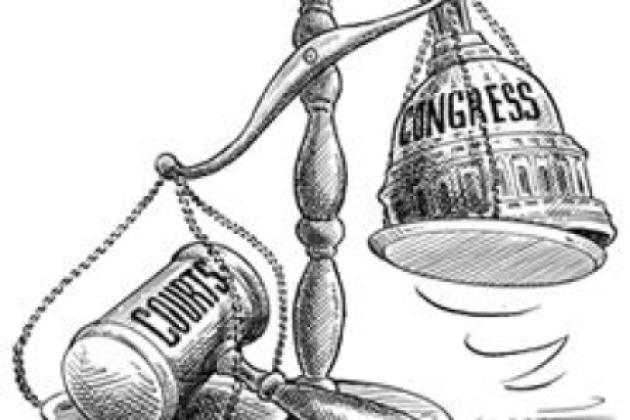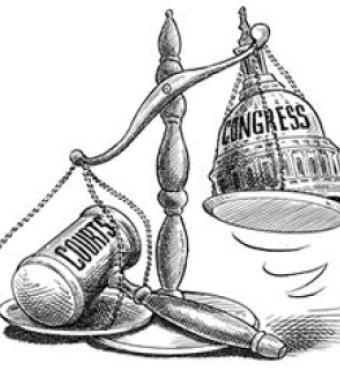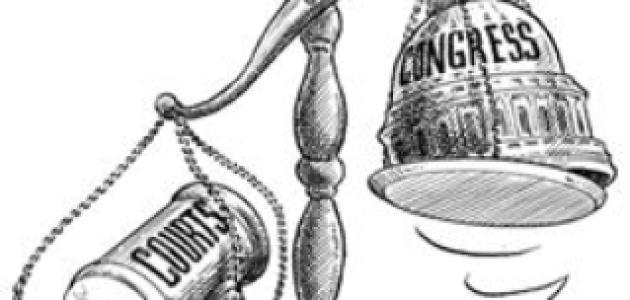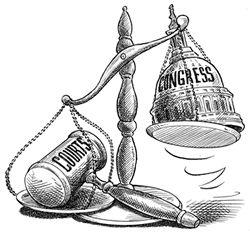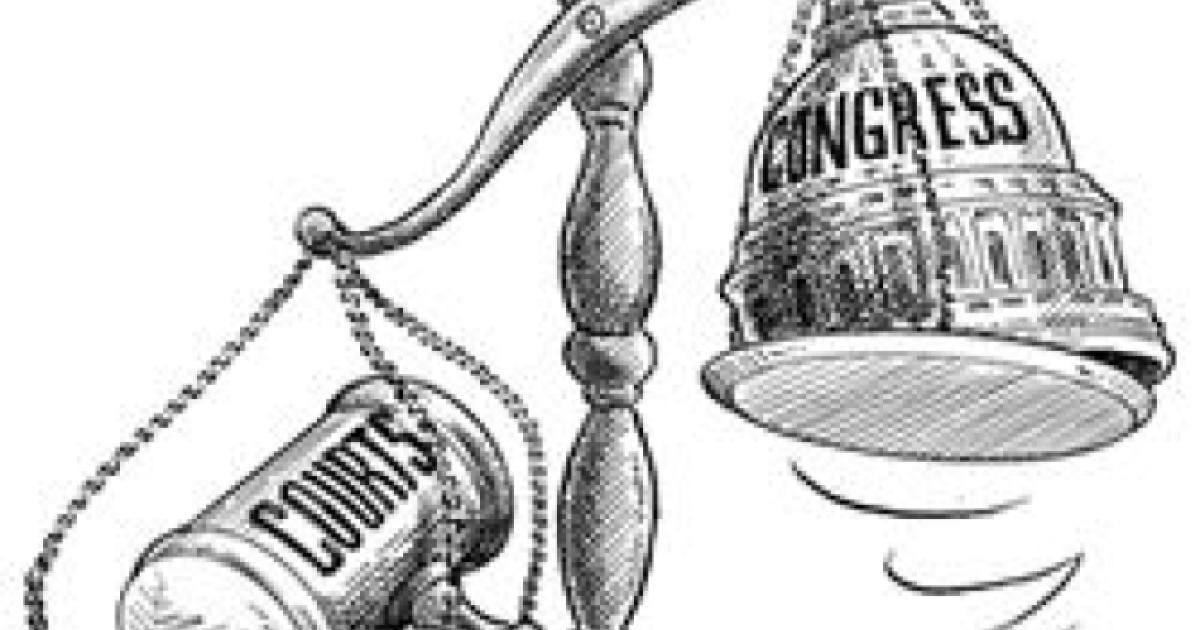- Law & Policy
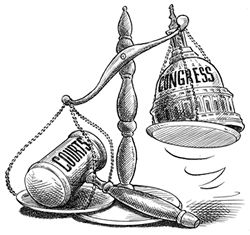
Classical democratic theory associates politics with the activities of the legislature and law with the operation of the judicial branch. Politics is natural to the operation of the legislature and both unavoidable and legitimate there. Indeed, political contestation is understood as necessary to realize core democratic values. The legislature makes laws that are binding on all of us, and each of us therefore has a stake in deciding who should sit in the legislature. We are entitled to monitor legislative debates, to have timely input and influence on legislative decisions, and to demand that legislators stand before us in elections to account for what they have done. These political expectations entitle us to organize parties and factions to elect, monitor, criticize, oppose, and otherwise influence lawmakers. In this sense, lawmaking politics is expected to be contentious, partisan, and ideological.
By contrast, the application of law is supposed to happen in courtrooms. The application of law may be controversial but is expected to be mostly a technical matter of finding the right principles under which the dispute can be settled. The duty of judges and legal officers is to provide fair and unbiased tribunals before which conflicting parties can settle their disputes under preexisting valid legal norms. The courts are not places where general and prospective regulations are formulated, nor are they places for partisan activities. The two activities—legislative and judicial—are to be conducted separately, according to different principles.
Blurred Lines
Nowadays we recognize the notion that politics can or ought to be confined to the legislative process as too simplistic. We also recognize that courts have been increasingly able and willing to limit and regulate the power of legislative institutions, which means courts have increasingly become places where substantive policy is made and where judges have become increasingly willing to regulate the conduct of political activity itself. This growing role of the courts both in policymaking and in politics means that a phenomenon that Tocqueville noted about American politics years ago has now turned global: the transformation of political questions into legal ones.
Why is this transformation taking place? In a republic the legislative power is supposed to be exercised, directly or indirectly, by the people. That is why legislative power is always, initially, vested in a representative legislature. But although constitutions and public expectations may associate the legislative power with the legislature, that power can and will relocate itself among governmental institutions—and historically it has done so repeatedly.
The model of a popularly accountable legislature does have a certain austere elegance, but it does not take into account the complexity of making good rules. Lawmaking is inherently fraught with uncertainties in that no one can know what the consequences of a newly adopted rule will be. We hope, of course, that the legislature will adopt internal institutions and practices that manage this uncertainty intelligently. In the United States, Congress has adopted a complex committee system with extensive professional staff, and members of Congress have often become substantive policy specialists. In other countries, the government, which is a particularly powerful committee of the legislature, marshals the resources of the executive departments to manage legislative uncertainty. But no matter how well the uncertainty is managed, one can never fully anticipate the effects of prospective rules.
The delegation of authority to specialized administrative agencies is a partial response to this lawmaking uncertainty. Rather than trying to anticipate all the complexity that a general rule would need to respond to, Congress authorizes administrators to develop more-detailed rules. Still, administrative rule making tends to be a fairly rigid and costly enterprise, and rules—once adopted—are nearly impossible to alter should their anticipated effects fail to materialize.
In view of the intractable uncertainty of lawmaking—in agencies as well as in legislatures—courts do hold some unique advantages. Courts consider rules in light of specific circumstances and are well positioned to see the injustices and inconveniences posed by these circumstances on litigants. Although the rules courts develop are prospective—they are precedents for similar cases in the future—the resolution of the case before them is not. Moreover, the practice of stare decisis (sometimes called “precedent”) permits the gradual development of general rules through the activities of many courts and judges and cases. As lawyers have argued for centuries, this kind of experience can help to shape rules that are well suited to actual circumstances of interaction.
It is here, I think, that we hit upon two general causes of judicialization. First, the increasing fragmentation of power within the political branches often limits their capacity to legislate—to be the place where policy is effectively formulated—meaning people seeking resolution to conflicts will gravitate to institutions from which they can get solutions. Courts often offer such venues. Second is the sense that courts (at least certain courts) can be trusted to protect a wide range of important values against potential political abuse. In other words, the public’s waning confidence in the legislature’s ability to legislate its interest can turn its hopes and desires toward the courts.
This is particularly apparent in post–World War II Europe. The need to ensure that ordinary lawmaking would be regulated by fundamental values was especially felt in Italy and Germany: The ordinary lawmaking processes in those countries had completely failed to respect human rights. But not only was the legislature suspect as a defender of fundamental rights, so too were the ordinary courts, which had done little to control or limit the impact of authoritarian legislation. The institution of new constitutional courts—which would have the power to overturn legislation but be independent from the judiciary itself—was part of a response to this double distrust of the legislature and the ordinary court system.
Fragmentation
The level of fragmentation among political branches varies from one system of government to the next. In the United States, for example, the instances in which a majority party has been able to coordinate and discipline its legislative activities have been rare and brief: Franklin Roosevelt’s first or second Hundred Days, LBJ’s 89th Congress, and Newt Gingrich’s “Contract with America” in the 104th Congress are perhaps the only examples. This is due in part to an electoral system that effectively makes each member of Congress a kind of ambassador from his or her district or state, and in part to the fact that the president is elected separately. Legislators in such a system are given every motivation to respond to the diverse needs of their constituencies rather than to band together behind a coherent party program—ideal circumstances for fragmentation, and therefore ideal circumstances for a greater reliance on the courts for what should be legislative outcomes.
European political institutions—Great Britain excepted—are a textbook instance of fragmentation: They combine a federal structure with extremely indecisive political institutions that are required to make decisions using either unanimity rule or qualified majority rule. In this context, European bureaucratic and judicial institutions have flourished. The European Commission has been accorded a wide latitude for formulating policy initiatives, and the European Court of Justice has been just as effective in establishing jurisdiction over national laws or ordinances that affect the movement of goods, money, and people throughout the European Union.
Institutional fragmentation can be overcome if the political parties are sufficiently well organized and self-disciplined. One-party systems, such as those that used to exist in the Soviet Union and continue in modern-day dictatorships, obviously experience little fragmentation. Western European political parties are usually quite disciplined but do not typically obtain parliamentary majorities—the one exception being the British Westminster model in which one party usually attains a majority and maintains tight discipline in parliamentary votes. Legislative power is, in effect, never fragmented in Britain.
Judicialization on the Rise
Politics tends to follow legislation because legislation is an inherently political activity. It is therefore logical that as courts assume more legislative-like activities—whether due to fragmentation or a willingness to protect a wider collection of rights—that politics will follow. This migration of legislative powers to agencies and courts means that agencies and courts, especially courts, will be making politically consequential and more-or-less final decisions. This means two things: First, anyone with an interest in those decisions will have reason to seek to influence and, if possible, control appointments to the courts and other legal institutions; second, part of the policy debate over new legislation must now aim at anticipating the response of legal institutions. This politicization of the courts, or the transformation of political questions into legal ones, is exactly what Tocqueville predicted more than a century ago.
This judicialization of politics also leads to the judicial regulation of politics. Recent legal regulation of democratic practices has focused on developing constitutional doctrines that permit courts to reshape political practices. For instance, much of the important action is now taking place in the courts on issues such as apportionment, access to the ballot box, campaign finance, and other modes of regulating political life that were long shielded from judicial scrutiny. Another striking development is the increasing willingness of the courts—the U.S. Supreme Court in particular—to impose what might be called deliberative requirements on legislatures. This tendency is most pronounced in a recent series of federalism decisions where the Court has demanded that Congress provide a reasoned justification for its authority to enact statutes. As others have noted, the Court seems to be treating the legislature, in this respect, as it would an agency or even an inferior court. This is significant because, even if the Court leaves the exercise of legislative authority undisturbed, the demand that the authority be connected to adequate reasons, as judged by courts, has the effect of forcing the legislature to act like a lower court when enacting statutes. And the Court’s willingness to impose such increasing constitutional restrictions on legislatures can be explained in terms of its increasing political independence of the other branches.
Lawmaking will tend to migrate to those bodies that are capable of decisive action. And if these actions have political implications, politics will necessarily follow the lawmaking—wherever it may occur. This does not imply that there is anything wrong with judicial rule making having political aspects. Quite the opposite. The power to make rules ought to be the subject of political contestation and deliberation by those whom the rules affect. The shape of judicial politics is and ought to be, however, different from that surrounding the political branches. Courts need to take care when relocating specific legislative issues to legal settings; taking such care requires the formulation of normative standards to guide the allocation of legislative authority.
Norms and Reforms
What might such normative standards look like? Perhaps different kinds of legislation should be made in different but appropriate institutional settings. Courts are well suited to make certain kinds of legislative rules, such as those answering to principles such as equality, due process, and justice. This is not to say that the legislature should not participate in making policy concerning these values, only that courts have an important and continuing role in regulating legislative activities in these areas. Similar considerations should govern when administrative agencies legislate rules. Rules that need to be responsive to technical issues are often best formulated in settings where expertise and professional norms can shape the policy discourse.
The desirability of developing and enforcing norms for governing the location of legislative authority is of course no assurance that such norms will in fact develop or be applied. Specifically, it is doubtful that American judges protected by life tenure and chosen in partisan political processes can be relied on to exercise precisely the kinds of nuanced restraint that would be called for; it is therefore inevitable that under certain circumstances judges will exercise legislative powers in areas where the legislature itself ought to do so.
It may make sense therefore for Americans to consider some reforms that could alter the dynamics of our courts, in particular the U.S. Supreme Court. Already in place in European constitutional courts are reforms such as requiring a supermajority in the Senate to confirm appointments and limiting justices to a single nonrenewable term; their empirical experience might be informative. A supermajority requirement to confirm appointments would mean that newly appointed judges would have to be acceptable across party and ideological lines, which would discourage the appointment of ideologically extreme judges and probably lead over time to a court filled with judicial moderates. Fixing judicial terms would mean, among other things, that if members did become extreme once appointed, they could not serve for more than their allotted term.
A natural response to such reform proposals is to ignore them because they are unfeasible, especially the idea of imposing term limits on court appointments, which would require amending the Constitution. A supermajority requirement, however, would not require constitutional change. Such a reform could be implemented conventionally, much as the British change their constitution. If members of the Senate regarded a two-thirds majority as a self-imposed requirement, they could refuse to approve any nomination that failed to receive that level of support. Whether senators could withstand the political heat from such a stand is of course another matter.
The political aspect of courts in certain government structures is to an extent not only unavoidable but also legitimate. Democratic responsiveness and legality are complex and sometimes conflicting ideals, and what each of them requires at any point in time is an open question. The practices of judicial rule making are therefore right at the contested boundary of these concepts. What is at stake here, institutionally, is the allocation of legislative power; in the years following World War II this power has been consistently shifting away from legislatures and toward courts and other legal institutions. The result is not only that more legislation is being made in the courts but also that that legislation that does occur in other institutions is increasingly subject to a process based on judicial regulation. If this judicialization of politics is inevitable, as history seems to suggest, then whether it proves to be beneficial depends on the reactions of the very institutions that permitted the transformation of the political into the legal in the first place.








